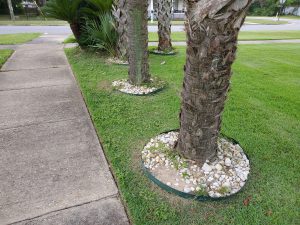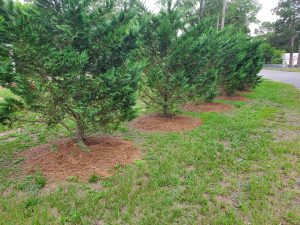A lot can go wrong in a garden or landscape, but proper preparation can help to avoid many of these problems from popping up in the first place. For some of these problems, a good preventative measure is mulch.
Mulch is any material that’s spread over the surface of the soil. One of the most common materials used in our area is pine straw, which is simply the needles of pine trees harvested from forested lands. Pine bark, another byproduct of the forestry industry, can be found easily as well. Both of these mulches will tend to have an acidifying effect on soils over time.
Other popular mulches include shredded or chipped wood. Melaleuca trees were originally planted in South Florida in an attempt to convert wetlands into farmable areas; to help remove this invasive species, the trees are now cut and ground into mulch. Eucalyptus mulch is also popular, as well as cypress, though it can be difficult to determine where cypress mulch originated from. Improperly harvested cypress can damage Florida’s natural wetlands. Hardwood mulch from other species may also be found.
Utility companies may sometimes give away mulch produced as they trim trees and bushes along their power lines, but this should be used only with the understanding that it may contain weed seeds or traces of herbicides or other chemicals. Homeowners may sometimes produce their own mulch in the form of raked leaves or grass clippings, but the same concerns about weed seeds and chemicals apply here as well.

Mulch can be used to help avoid hitting plants with a mower or trimmer.
Gravel or pebbles may often be used, especially in wet areas, or close to houses where flammable materials may be ill advised. Lastly, garden mulches may include materials such as paper or plastic spread in sheets over the ground.
Choosing the proper mulch can depend on the reason for its use. There are a number of effects mulch can have on a garden or landscaping bed. Mulch can help to retain moisture in the soil, keep weed growth down, reduce erosion, and act as a temperature buffer for the soil and plant roots below. It may also add visual appeal and help to keep lawn mowers and trimmers from needing to get too close to plants which may be damaged by them.
Whatever the reasons for adding mulch, there are a few things to avoid. Do not mound mulch around the base of plants. Moisture held against the trunk or stem of a plant can lead to fungal problems. Try to maintain a layer two to four inches deep. Any less and weeds will grow through the material; more mulch will not allow water to filter properly to the ground. Finally, if mulch becomes clumped and matted over time, do not let these block air or moisture to areas below. Rake or stir the mulch to evenly spread it.
You can find more information on mulching at our EDIS site https://edis.ifas.ufl.edu/topic_mulch or in the Florida Friendly Landscaping site at https://ffl.ifas.ufl.edu/handbook/Mulch_vSept09.pdf.
- The Eastern Lubber Grasshopper - June 5, 2025
- Grass is Growing; Time for Mowing - April 30, 2025
- Variegation, Viruses, and You - June 27, 2024

